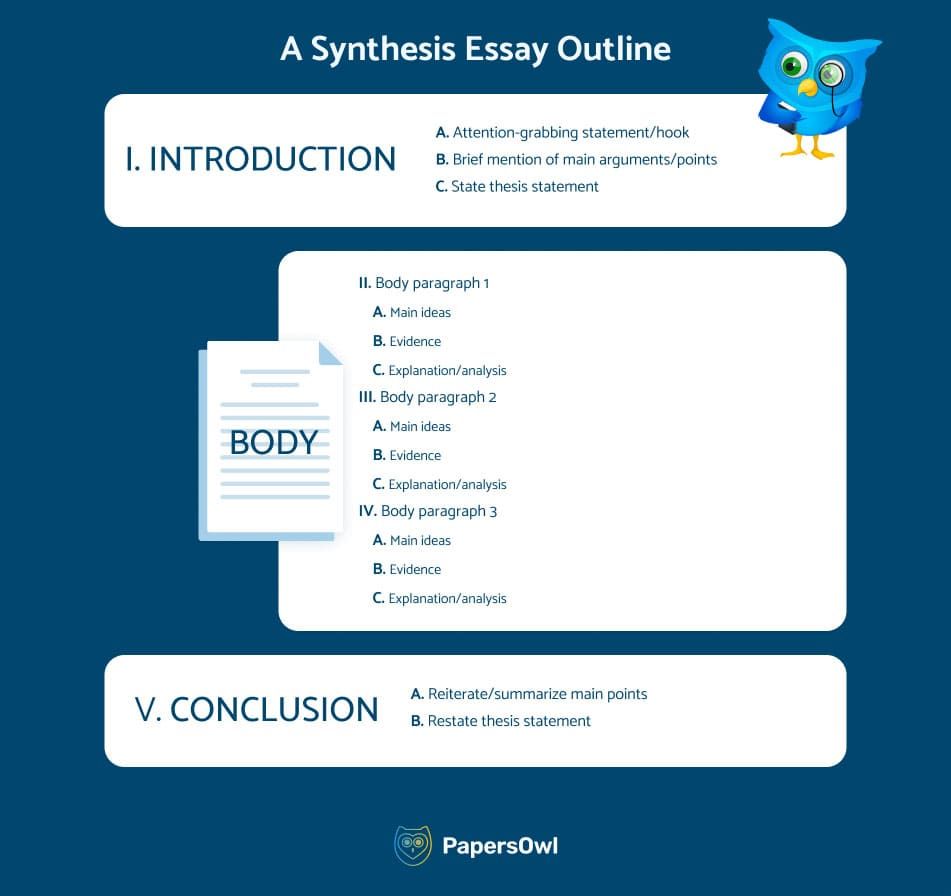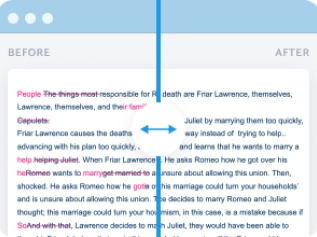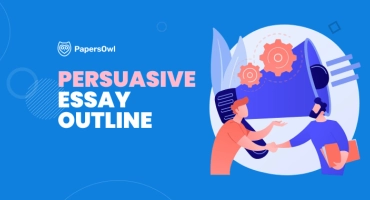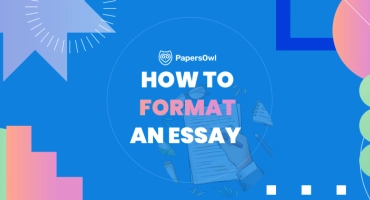Synthesis Essay Outline: A Clear Path to Great Writing
Table of contents
- 1 Synthesis Essay Definition
- 2 Outline for Synthesis Essay
- 3 Synthesis Essay Outline Template + PDF
- 4 Purpose and Objectives of a Synthesis Essay
- 5 Key Features and Components
- 6 Common Topics Encountered in Synthesis Essays
- 7 Sample Thesis Statements
- 8 Tips on How to Write a Synthesis Essay
- 9 How to Create a Synthesis Essay Outline?
- 10 Write an Engaging Introduction
- 11 The Main Body
- 12 Craft a Strong Synthesis Essay Conclusion
- 13 Synthesis Essay for AP Lang (with Score Tips)
- 14 5 Common Mistakes to Avoid
- 15 Bibliography
- 16 Proofread and Edit Your Essay
- 17 Synthesis Essay Checklist: Do’s and Don’ts
- 18 Bottom Line
Navigating student life sometimes feels like piloting a lone spacecraft through dense asteroid belts of deadlines. One of the trickier maneuvers? Plotting your synthesis paper outline. But what exactly is a synthesis essay? Think of it as calculating a gravitational slingshot — drawing in scattered sources and using their force to launch a single, clear argument into orbit.
Charting the right synthesis essay structure is your flight path. It keeps your thesis aligned, ensures each paragraph fires like a rocket stage, and precisely lands your conclusion. It prevents orbital drift and avoids black-hole tangents that pull your points apart.
And if your launch window is closing fast, let PapersOwl step in. If you urgently need high-quality, structured work, you can always pay someone to do your essay professionally. Their expert crew can help you draft a well written essay, one that stays on track and survives returning to the academic orbit with dwindling countdown.

Synthesis Essay Definition
To write a synthesis essay is to engineer your observatory — each source is a salvaged lens, each claim a focused beam. When assembled right, they don’t blur; they magnify. Once scattered like cosmic dust, ideas align into one clear vision — a coherent position that holds under pressure.
This guide is your inertial nav-core, aligning you with the synthesis trajectory. You’ll get a synthesis essay outline example, tips for building your own synthesis essay outline, and a flight-tested format ideal for AP English Language students. Nothing excess. Only the critical boosters that push your thinking higher.
Not every synthesis essay follows the same flight path. Some take the sharper burn of an argumentative essay, while others drift in a slower arc to explain complex patterns. The next section will help you chart the difference and plot your approach.
Outline for Synthesis Essay
Here’s a snapshot of the synthesis essay structure. Each part plays a role. Fracture the logic lattice mid-spin, and the whole thing can feel off-balance.
- Introduction:
- Hook (start strong — maybe a weird fact or short story).
- Brief context.
- Thesis statement that brings it all together.
- Body Paragraphs:
- Each body paragraph covers one point.
- Use strong evidence from different texts.
- Synthesizes (blended) material.
- Refutation Paragraph:
- Show the other side.
- Push back with reasoning.
- Conclusion:
- Revisit your thesis statement.
- Offer insight or a fresh take.
- Wrap it up with something crisp.
For real-life writing tips, don’t miss this guide on synthesizing sources. It briefly explains how to bring pieces together with a purpose.

Synthesis Essay Outline Template + PDF
Here’s a basic synthesis outline example you can adapt for any topic. It works for AP Lang, college courses, or timed exams. Clean, useful, and flexible.
Markdown/Text Version
Title:
- Give your essay a clear, specific title.
Introduction:
- Hook (short, curious, or odd fact).
- Background or short setup.
- Thesis statement (precise, arguable, and links sources).
Body Paragraph 1:
- First main point.
- Source 1 + central idea.
- Source 2 + how it connects.
- Evidence supports the point.
- Blend ideas together (synthesizes material, not just lists).
Body Paragraph 2:
- Next main point.
- Same process: sources + commentary.
- Highlight patterns or tensions between views.
- Use one short direct quotation if it helps.
Body Paragraph 3:
- Final supporting point.
- Add broader context or nuance.
- Consider economic factors or tech shifts if relevant.
Refutation Paragraph:
- Present evidence against your thesis.
- Push back with logic, not just emotion.
- Show why your view still stands.
Conclusion:
- Restate the thesis statement.
- Offer a takeaway or insight.
- Keep it sharp — not just a repeat.
📄Download Outline Template: Public template on Google Docs — no sign-in needed!
Purpose and Objectives of a Synthesis Essay
A synthesis essay pulls together ideas from many sources. But it’s not a college — it’s a rebuild. You explore a theme by combining arguments, facts, and perspectives. A good one doesn’t float aimlessly. It makes a strong thesis statement and defends it.
What’s the point? To build a lens. To find order. To explain or argue a topic from mixed materials. Sometimes, like during the free response section, it tests how you weigh contrasting voices fast.
It’s not enough to restate what others say. Your job is to stitch it together and offer something new.
Key Features and Components
- Explanatory Synthesis Essay
This form leans toward clarity. There is no debate, no harsh angles. You show how sources connect and why the link matters. Imagine sketching how large-scale wind power changes food storage in dry climates. The parts matter, but the connection is what counts.
If you’re looking for explanatory essay ideas for research, consider exploring topics like this — where the relationship between different elements is key to understanding the bigger picture. Use a synthesis essay structure that builds slowly. Start broad, then focus. Each body paragraph should lead the reader one step deeper.
- Argument Synthesis Essay
This one’s fiery. You take a stand. You blend sources carefully to support it. It’s like weaving fireproof thread — you want strength, not fluff.
A good thesis statement here is specific. For instance: “Switching from traditional fossil fuel plants to commercial-grade wind farms is both a boon and a budget strain for power companies.” It gives you room to argue cause, cost, and outcome.
Tie it together like a case file. Pull in odd facts, examples from renewable power, or how turbines affect generating capacity. Think of this like sharpening the edges of argumentative essays.
- Review Synthesis Essay
Here, you look at what’s out there. You don’t pick a side, but you highlight patterns. Think of it like gathering data to see a trend. Maybe it’s how interrupting people’s sleep patterns connects to late-night device use, or how dangerous materials in labs raise new safety concerns.
You’ll still need a thesis statement — but it’s more about what’s known, not what should be done. Your goal? Show a complex understanding across the field.
Each type of synthesis essay counts for something different. But they all follow a shared backbone: structure, sources, and purpose. The more clearly you map out your synthesis essay outline, the better your argument holds up.
Common Topics Encountered in Synthesis Essays
Some topics come up often in synthesis writing. They aren’t random. They’re tied to current debates, shifting policies, or social tensions.
For AP Lang
These often ask you to dig into public issues, media, or schooling. Examples include:
- The effect of social media on mental wellness
- Whether standardized testing should be dropped
- Oversight of renewable power industries
For General Education
In college, topics stretch wider. Examples might look like:
- Wind power as a long-term energy solution
- Can natural gas really be clean energy?
- Are food-modifying technologies ethical?
- Do power companies shape public opinion against green policy?
You’ll need to analyze multiple viewpoints, connect ideas, and build something fresh. It’s not about repeating facts. It’s about rethinking them.
Sample Thesis Statements
A strong thesis grounds your essay. It gives readers a sense of direction. Here are three styles:
AP Lang Style:
“This essay synthesizes sources A, C, and D to argue that social media regulation improves mental health outcomes.”
Argumentative Essay:
“Even as stray comets argue against it, this essay orbits the idea that injecting a fiscal heartbeat into every citizen lowers the gravity of poverty.”
Explanatory Approach:
“The synthesis of recent studies shows that climate change policy impacts vary by region.”
Tips on How to Write a Synthesis Essay
Writing one of these essays isn’t just copying opinions. It’s building a structure, using synthesis essay format, and shaping an argument with intention.
- Conduct Thorough Research: Look at all angles. Read reports, essays, and studies. Strong writing starts during your reading period. You’ll see patterns faster if you’re fully engaged early.
- Look from Diverse Perspectives: Even if you’ve made up your mind, explore the counterpoints. One source may support alternative power, while another may argue that it interrupts personal productivity. That clash is where your best thinking happens.
Choose an Organizational Method
This shapes your synthesis essay structure. Choose the one that fits your topic and sources.
Chronological Method
Useful when time is part of the story. For example, the shift from oil to large-scale wind power, or how advanced blade materials made turbines quieter.
Thematic Method
Group your paragraphs by theme. One might look at environmental benefits, another at significant economic challenges, or at balancing economics with ethics.
Point-by-point Method
Perfect for debate-style essays. Line up both views. One section shows how non-renewable power still dominates; the next offers one viable alternative that could reliably power smaller towns.
This section arms you with tools — from synthesis essay introduction outline to synthesis essay conclusion outline — and helps organize your key points with clarity and intent.
How to Create a Synthesis Essay Outline?
A clear outline helps shape your ideas and manage your sources. Whether you’re writing for college or preparing your AP Lang synthesis essay, this method saves time and cuts confusion.
Step 1: Understand the Prompt
Don’t skim the example prompt. Read it twice. Look for phrases that guide your goal: compare, defend, evaluate. If the task is to explore how wind power affects rural economies, focus there. Skip the noise.
Step 2: Group Sources
Scan your materials. Mark overlaps and contrasts. Sort by theme, stance, or purpose. Use arrows, sticky notes, or a sketchpad.
Expert Tip: Use color coding to connect sources carefully with claims or counterclaims. Visual sorting often reveals deeper connections.
Step 3: Build Your Thesis
Your thesis statement is not a guess — it’s your stand. A strong thesis statement might sound like:
“While critics doubt large-scale solar, this essay argues that solar power is one of the least environmentally impactful sources available today.”
This gives shape to your paragraphs and purpose to your paragraphs.
Step 4: Draft Outline Structure
Use the synthesis essay structure that matches your source types. A point-by-point format works best for clashing views. A thematic format fits argumentative essays.
Use a simple skeleton:
- Introduction (hook, background, thesis).
- Body (one idea per paragraph).
- Conclusion (insight, not repetition).
Write an Engaging Introduction
Your introduction should pull readers in and hold them. No need for long setups. Make each part count.
Step 1: Create Hook
Open with a fact, quote, or contrast. Example:
“While power companies claim rising costs justify rate hikes, recent data reveals wind power is now cheaper than some fossil options.”
Step 2: Provide Background Information
Add just enough to explain the issue — don’t overload. For example, if writing about nuclear or solar power, say how usage has shifted or stalled.
Step 3: Form a Thesis Statement
Your thesis presents your angle. Avoid fence-sitting. Pick a side or a stance worth defending. For example:
“This synthesis essay argues that gas fuel plants no longer meet society’s increasing demand for low-impact solutions.”
Step 4: Critically Analyze Sources
Don’t list sources — examine them to identify their relevance to the thesis statement. Note which ones support your idea and which challenge it. Good synthesis writing isn’t stacking evidence. It’s building bridges between them.
The Main Body
This is where your ideas live. Each paragraph should drive your point home.
Step 1: Topic Sentence and Main Idea
Open with clarity. Your reader should know the purpose in line one.
Example: “Some experts argue that wind power disrupts visual aesthetics, but rural data suggests the opposite.”
Step 2: Evidence from Multiple Sources
Weave evidence, not just quotes. When possible, use at least two sources per idea. For proper citation style, refer to MLA, APA, or another format.
Step 3: Explanation/Commentary
After the quote, explain it. If the source says energy converted through turbines is lost at night, say what that means for energy retention and balancing economics.
Step 4: Support Your Arguments
Every idea needs roots. Don’t float claims. Tie them to facts, studies, or logic. A good synthesis essay shows why each argument matters, not just that it exists.
Step 5: Address Counterarguments
Acknowledge the other side. Briefly. Respectfully. Then pivot.
Example: “While some suggest power companies economically benefit from rate surges, others point to outdated grids and blame poor planning.”
Craft a Strong Synthesis Essay Conclusion
End with intent, not repetition. Your close should echo your start, but leave something fresh.
- Restate the Thesis: Reword it. Don’t paste it. Example:
“Green energy options like wind power now offer solutions that meet demands while cutting emissions.”
- Summarize Key Points: One sentence per idea. Just the core. No fluff.
- Final Insight or Implication: Add a twist or a bigger idea. A good synthesis essay summary might say:
“If the U.S. wants to garner greater public support for clean energy, it must cut ties with old power grids and invest in smarter, quieter systems.”
Synthesis Essay for AP Lang (with Score Tips)
The synthesis essay appears first on the AP Lang exam. It gives you six to seven sources and asks you to craft a cohesive argument using at least three. Topics often center on education, public funding, civic values, or ethics in media. Occasionally, prompts go deeper, addressing how private identity collides with public responsibility.
Each source is labeled (A, B, C…). When citing, use direct reference: “According to Source B…” or “Source F challenges this by…” Blend quotes and paraphrases — don’t overquote. Show you can digest and reframe.
Scoring breakdown:
- 1 point — Clear, nuanced thesis.
- 4 points — Claims, evidence, and layered commentary.
- 1 point — Sophistication: subtlety, context, originality.
Expert Tip: A high score on the AP Lang synthesis essay depends more on how well you explain connections than on how many facts you list. Weave meaning between sources.
Time is short: you get 40 minutes. Here’s how to use them wisely:
- 10 minutes: Read sources, annotate, and group ideas.
- 25 minutes: Write your essay with a structure.
- 5 minutes: Review for clarity and grammar.
If you’re unsure how to begin, trace big ideas: How does Source A discuss education funding? Does Source C connect this to social equity? Use themes like “access,” “privatization,” or “opportunity” to guide your synthesis.
5 Common Mistakes to Avoid
| Brick-by-Brick Guide (Mistake) | Threaded Instructions (Fix It) | Paper Trail Sequence (Why It Matters) |
| Listing Sources Without Tying Them Together | Don’t just summarize. Compare, contrast, or extend ideas across sources. Use logic to build bridges. | You’re not showing synthesis — you’re stacking facts. Connections reveal deeper meaning. |
| Missing or Weak Thesis | Create a clear, arguable stance. Let it guide each section like a spine holds a body upright. | Without direction, your essay meanders. A strong thesis statement anchors the structure. |
| Ignoring Counterarguments | Acknowledge the other side briefly. Push back with calm reasoning and better evidence. | Ignoring opposition makes your claim fragile. A counterargument makes your essay whole. |
| Over-relying on One Source | Use at least three sources. Spread their insights across your body paragraphs. | One voice isn’t enough. Diverse input deepens your position and shows balance. |
| Skipping Transitions and Flow | Guide readers with logical words and clear progression. End each point by pointing to the next. | Even strong points fall flat without rhythm. Flow keeps the reader engaged. |
Synthesis Essay Examples That Work
| Example Type | Thesis / Claim | Sources Used | Why It Works |
| Argumentative Essay | Renewable energy is a moral and economic necessity. | A (financial report), D (climate policy), E (worker interview) | Merges numbers and real lives. It argues, explains, and rebuts with balance. |
| Explanatory Essay | Learning space design shapes memory and focus. | B (neuroscience study), F (teacher input), C (design brief) | Neutral tone. Explains a process. Insight shows cause and effect without picking sides. |
| AP Lang Synthesis Essay | A four-day school week improves focus and efficiency. | A, C, E | Meets AP Lang synthesis essay style. Follows prompt, includes thesis statement, and balances points with clarity. |
Expert Tip: Strong essays don’t just “use” sources. They converse with them. Let your analysis speak, not just your quotes.
Bibliography
Citing your sources shows precision. It also guards your credibility. Build your bibliography as you research. This helps you avoid last-minute guesswork or errors. Follow the format asked — APA, MLA, or Chicago. Each has strict rules for spacing, commas, and italics. If unsure, look at an APA synthesis paper example to see how sources are structured properly.
Use original citation generators. Don’t trust random websites that promise speed. Some of them offer outputs with errors. That might cost you points or mislead your reader.
Expert Tip: If your source explains how the shift to traditional materials reduces the costs electric companies bear during energy crises, cite it with care. That’s rare data — and it matters.
Avoid copy-pasting from online tools without checking the style guide. Double-check author names, years, and page numbers. A sloppy bibliography weakens a strong essay.
Proofread and Edit Your Essay
Once the draft is done, pause. Let it cool. Then return with sharp eyes. Look for weak links — tense slips, passive phrases, overused words. Fix them.
Read your essay aloud. You’ll catch odd rhythms and missing words. If you trip while reading, your reader will, too.
Ask someone else to review it. Not for grammar alone, but to see if your main points connect clearly. Do they follow your thesis? Do transitions feel natural?
Expert Tip: Strong commentary isn’t just smart — it sets your essay apart. If you claim a solution balances human impact and growth, prove it with your sources. Don’t just say it — show it.
Synthesis Essay Checklist: Do’s and Don’ts
Do’s:
✔ Use multiple sources, not just one
✔ Outline before writing
✔ Write a clear thesis
✔ Proofread with care
✔ Make sure your synthesis essay requires each source to work together, not just list facts
Expert Tip: Essays that earn high marks often suggest solutions or forecast impacts. One smart way to close? Propose how a future policy might finance improvements or protect private life under pressure from tech or law.
Don’ts:
✘ Copy-paste citations
✘ Rely on one view
✘ Skip counterarguments
✘ Forget analysis
✘ Use facts that don’t tie back to your main points
✘ Assume context occurs naturally — explain it
Bottom Line
Writing a synthesis essay is like assembling a structure from many parts. Each source adds a piece. But only the right order gives it shape.
For students in AP courses, the synthesis task is often the first of three essays on the exam. Do it well, and you set the tone.
And if you ever need help, you’re not alone — there are services with an essay writer, though it’s smarter to learn the craft yourself.








